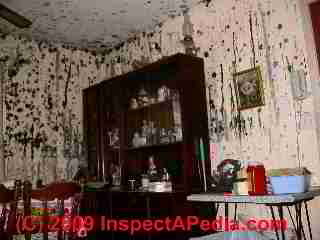 Mold Tests vs Mold Problem Diagnosis - a mold test may not accomplish what you thought
Mold Tests vs Mold Problem Diagnosis - a mold test may not accomplish what you thought
- POST a QUESTION or COMMENT about the difference between a simple mold test and more accurate procedures to find out if there is a mold contamination problem in a building
Mold test vs. mold contamination detection:
Here we distinguish between tests to identify mold in a building and procedures to determine whether or not there is a mold contamination problem in a building.
Following that distinction we continue by listing the specific reasons to test for mold or cases when mold testing is appropriate and useful.
InspectAPedia tolerates no conflicts of interest. We have no relationship with advertisers, products, or services discussed at this website.
- Daniel Friedman, Publisher/Editor/Author - See WHO ARE WE?
The Usefulness of Mold Testing vs. Mold Identification
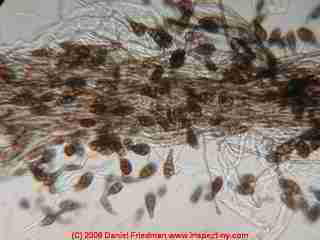 15th Annual North Carolina/South Carolina
15th Annual North Carolina/South Carolina
Environmental Information Association Technical Conference
Myrtle Beach, SC
Daniel Friedman 23 September 2005, updated thorough 11/19/2013
Abstract: In this article series we explain the difference between a mold test and a procedure to reliably identify a mold problem in a building.
[Click to enlarge any image]
We describe the validity of nearly all of the popular mold testing methods currently in use, pointing out the strengths and weakness of each approach to mold sampling in the indoor environment, beginning with air sampling for airborne mold levels indoors.
We explain that a "mold test" in a building, used alone, without an accompanying expert inspection, may be of little use because of the potential for major errors in the test procedure and test mechanism and because even if the test successfully collects evidence of building mold contamination, the mold identified may not be the most serious mold contamination present.
Finally, even if a mold test could properly identify the presence of the most serious mold contaminants present, it may be insufficiently diagnostic to give any guidance whatsoever about where the mold problem reservoirs are actually located, the extent of cleanup needed, and the cause of the mold growth.
All of those questions will require an additional expert investigation, evaluation, and possibly further testing before a mold remediation plan can be prepared. Nevertheless, as we outline in topic 2 below (a separate paper) there are reasons to test for indoor mold.
This discussion of the usefulness and validity of mold tests is divided into two main topics:
Mold testing discussion can be divided into two main topics, the first of which is discussed in this paper.
- MOLD TEST REASONS - reasons why in some conditions it is appropriate, useful, and cost-justified to test for mold and to identify the kinds of mold that are present in a building. We emphasize that for small areas of mold contamination, generally where less than 30 square feet of contiguous mold is present, simple building cleaning and renovation procedures are all that's needed and testing is usually not appropriate. Most building mold contamination falls in this first category.
Separately at MOLD / ENVIRONMENTAL EXPERT, HIRE ? we provide guidelines to help decide when it is probably justified to bring in a mold expert to perform mold inspection and testing in a building. - MOLD TEST vs. PROBLEM DIAGNOSIS - what is the difference between "mold testing" and "mold identification", and what good are consumer mold test kits. Why are "mold tests" alone of little use and insufficiently diagnostic?
Mold "Testing" vs. Mold "Problem Identification"
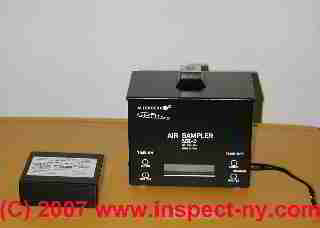 We are "making up" this temporary distinction to make clear an important point.
We are "making up" this temporary distinction to make clear an important point.
[Click to enlarge any image] Photo: an Allergenco air sampler in operation.
Mold Testing a building for the presence or absence of a problematic level of mold is unreliable if by "testing" one means a simple air test, an arbitrary surface or vacuum test, a swab test, or any culture method used alone and without a careful and complete inspection of the property. In particular, failure to detect problem levels of problem mold with an air, culture, swab, PCR or similar test (used alone) is not sufficient to conclude that there is no problem.
1. Airborne particle levels vary widely over short time intervals. What's in the air in a building varies enormously, possibly by a factor of thousands, over just a few minutes, depending on things like the level of activity, mechanical disturbance of dust, fans being turned on or off, hot air heat or central air being on or off, and more subtle changes in humidity, etc.
See
ACCURACY OF AIR TESTS for MOLD
2. Mold Culture Tests whether from a "home test kit" culture plate or a swab are unreliable as a characterization of presence or absence of mold because
- only about 10% of all of the 1.5 million mold species on earth will grow in any culture under any condition,
- because what grows on a particular culture may be what likes that culture not what is the dominant problem
- because accurate speciation of some of our problem groups
such as Penicillium sp. and Aspergillus sp. require arduous multiple cultures under very controlled conditions for reliable results.
See MOLD CULTURE TEST KIT VALIDITY
3. PCR tests are highly accurate in identifying individual molds, if you know what you're looking for. PCR is not reliable as a broad spectrum
scan to find what's in a building.
See
SWAB & PCR SAMPLING & TESTS for MOLD
Mold Problem Identification, as we are speaking here, is an important part of a building investigation for mold (or other allergen) problems.
By this we mean, an investigator should be charged to identify the presence of problematic mold, including no less than the following:
- first, the evidence that problematic levels of mold are present and that the predominant genera/species are ones which can be expected to be toxic or highly allergenic;
- second, the evidence that a large problem reservoir exists;
- third, the location(s) of the problem reservoir;
- fourth, the underlying causes for the presence of the problem reservoir.
This information permits preparation of a remediation plan to specify the cleanup needed and the building repairs needed to avoid simply producing more mold.
Key in a Mold Problem Identification investigation is the actual visual examination of the building, its history, its leaks, and other physical evidence.
As a part of such an investigation, samples are collected of visible mold to distinguish cosmetic from problematic material, and other samples might be collected to examine the level of moldy dust settled in building areas where mold is not present. Additional samples may be collected for comparison baselines such from outdoor areas or from non-complaint areas in the problem building.
A thorough building investigation will include sampling or "tests" to identify the presence of mold and to identify the dominant problem molds by genera and often species.
By contrast, a quick and simple "mold test," particularly a random spot check, is of little value by itself: grabbing a 90 liter air sample or putting a settlement plate in a closet for an hour is not a reliable building characterization for mold, and a tape sample of the single square foot of mold in a building is unnecessary.
Clean up small areas of mold growth without testing
If there is no large mold area, no leak history, no at-risk occupants, in sum, if you simply have a little moldy area, just clean it up, and spend your "test kit" money on cleaning supplies or dinner out. Small amounts of mold can often can be cleaned-up by the occupant or owner provided that person has no special allergy or risk regarding mold.
Some states define
"small" as less than 30 sq. ft. of contiguous mold. Your own area may
use a different criterion. Larger areas of non-cosmetic mold are likely to
require work by a cleanup professional. If you think you need to hire someone,
seeMOLD EXPERT, WHEN TO HIREor more detailed help in deciding when and how
to proceed.
Are Home Test Kits for Mold Useful? Accurate?
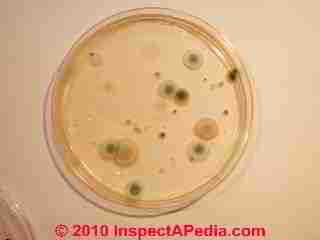 Settlement plates, culture media, or swabs which are later cultured, used alone for building mold risk analysis are invalid methods which risk both false
positive results (saying there's a problem when there is not) and false negative results (missing an important problem). More about this is in this
article and you can read in greater depth
Settlement plates, culture media, or swabs which are later cultured, used alone for building mold risk analysis are invalid methods which risk both false
positive results (saying there's a problem when there is not) and false negative results (missing an important problem). More about this is in this
article and you can read in greater depth
at MOLD CULTURE TEST KIT VALIDITY .
What about other do-it-yourself tests? Amateur mold "testing" by a homeowner, using a tape lift of visible mold, perhaps with some good advice on where to look, might be an inexpensive way find out that the "black mold" on the floor joists is a "cosmetic-only" mold, thus avoiding the cost of a more expert professional building investigation/remediation.
However anyone using this approach should understand that it is incomplete and superficial: you might collect your sample from a spot which is not representative; you will not address the risk of hidden mold in building cavities; you will not have expert mold remediation advice; you will not have baseline data to support a later clearance test after cleanup, finally, you risk leaving another problem in the building.
These warnings should be considered carefully where large areas of mold are already visible or at-risk occupants are involved.
Of the mold samples sent to our lab by owners who have had no collection advice, we find that "black molds" seem to be over-represented and we suspect these are often not the real problem in the building. The mold the owner sees may be simply the indicator of moldy conditions.
Lighter, harder-to see molds in the Penicillium sp. and Aspergillus sp. families, for example, are under-represented in owner-collected samples (based on our field experience and on our review of statistics of samples sent to Dr. J. Haines at the N.Y. State Museum for identification) because these genera are often more difficult to see.
Reader Question: advice for asthma sufferer considering testing indoor dust samples for mold, fiberglass, other particles
 Can you please tell me what you charge for lab analysis of sticky tape dust samples?
Can you please tell me what you charge for lab analysis of sticky tape dust samples?
[Click to enlarge any image] Photo: an indoor dust sample containing colorless Pen/Asp spore chains, fabric fibers, skin cells, mite fecals, and other fungal spores.
- Test for non-biological particles: Also, do you look for both biological and non biological particles? If so:
- Insulation fibers: Can you differentiate between fiberglass and rock-wool insulation product fibers?
- Mold identification: Are you able to identify mold spores to the genus level?
- Mold contamination vs. normal levels: Can you do a good enough estimate of spore count to determine whether there is an active problem or whether the spore was carried into the environment by foot traffic?
I would like to do dust samples in the living area, basement, and in the HVAC ducts.
I am suffering from a severe asthmatic condition that has worsened in the last few years despite the best efforts of several doctors. The problem affects me indoors and only seasonally when the house has to be closed up for AC or heat. Although the 70 year old home (I have lived in it since 1979) has never suffered water damage of any kind, I did have the humidity cranked up very high for several years during the winter months.
However, there is no visible mold except for a few darkened areas of insulation in the attic near areas where air leaked in from the living envelope. That insulation has been removed. The attic joists have been foamed to seal cracks around electrical boxes and the DWV pipes, and new fiberglass insulation added. HEPA vacuumed area during cleanup.
- Using mold sprays: Also I sprayed dark discolored areas on the bottom of the roof deck with Concrobium (Is this stuff any good?)
- Anonymous by private email, 2016/11/10
Reply: suggestions for inspecting & testing a building thought to be causing problems for an asthmatic person
Thank you for asking about our testing services, Anon.
I've retired from performing environmental testing or inspection services to the public with a few pro-bono exceptions that you can review [at INSPECTION & TEST FEES ]
My fee for analysis of a tape sample of dust or suspected mold was $50. which will be similar to most labs. An onsite inspection, when justified at all, if done properly is going to cost more than $1000. + any lab costs. It's not something appropriate for all cases and often you can follow my website's advice to get a reasonable idea of what's going on in your building.
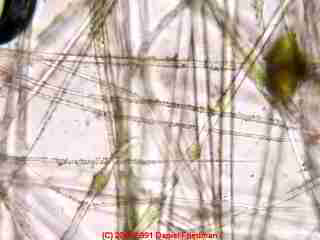 First let me offer a few suggestions and answers to your note:
First let me offer a few suggestions and answers to your note:
The steps you've already taken are reasonable and probably inexpensive, though I suspect that some of them were not likely to have addressed a significant problem-particle reservoir if one is present.
And as I'll suggest below, if you haven't already done so, as an asthmatic there are simple things you want to do to reduce a building's role as a source of respiratory irritants such as removing wall to wall carpeting.
Start with your doctor: You should always consult with your doctor about his or her advice for reducing the contribution of your home or workplace to asthma problems. There is both general advice for reducing dust levels or cleaning, and specific advice about reducing exposure to specific allergens or asthma triggers.
- Test for non-biological particles: In my opinion a lab that looks at environmental samples from a too-narrow view of just identifying mold spores or fragments isn't doing the proper job since there are other common indoor particles such as insect fragments, irritating levels of fiberglass, pollen, etc. that can be, at high levels, an indicator of other problems that can lead to a "wrong guess" at a mold problem.
- Insulation fibers: Fiberglass insulation (photo shown here) is pretty easy to distinguish from mineral wool. Sometimes by identifying a type of fiber or even a specific color of fiberglass insulation (actually its resin binder) an indoor dust sample will point to a probable source of high levels of indoor dust and thus it may be a useful diagnostic.
See FIBERGLASS INSULATION IDENTIFICATION & PROPERTIES
and
See MINERAL WOOL - ROCK WOOL INSULATION - Mold identification in mold tests: Most labs can identify the genera/species of many mold spores or conidiophores found in samples (as do I) but there are some spores that, when found alone ( that is just spores without the accompanying spore-producing structures that we can find in a tape sample of mold growing on a surface) can be just about impossible to differentiate.
For example a small Aspergillus sp. spore, depending on species, looks a lot like a small Penicillium sp. spore, and many basidiomycetes of the same size, shape, and surface smoothness look alike. Often a lab will refer to the combined class of these spores as Pen/Asp.
However there are many mold species such as Aspergillus niger than can be identified from the spore alone, and similarly most pollens can be identified from individual pollen grains, as can many other indoor allergens and irritants such as mite fecals, cockroach fragments, rodent hairs, animal hairs (dog, cat, rabbit, mouse).
Also see FIBER & HAIR IDENTIFICATION
And significantly, even low levels of certain fungal particles such as Aspergillus or Penicillium spores in chains or the presence of fungal conidiophores - the spore producing structures - can indicate that there was a mold spore reservoir near to the test location even if the actual spore level in the sample was low.
Keep in mind that for removing and preventing mold contamination, the species isn't going to change the cleanup plan.
But there are other reasons to identify them more specifically such as for medical reasons or to permit proving whether or not the dust control during a cleanup job was adequate. Spore counts are basically junk science but data that labs offer in response to market pressure. A count of a tape sample is absurd since moving the tape over an inch could produce zero or thousands of times more spores or particles or even completely different genera/species in most situations.
See MOLD TEST REASONS for details. - Mold contamination vs. normal mold levels: all indoor air and dust samples will almost always contain a few pollen grains and mold spores since those particles are usually in outdoor air and they enter the building through windows and doors as well as on people and pets. Incidental levels of such spores can be recognized by most microscopists.
Watch out: "Air tests" for mold have similar variability of several orders of magnitude and can completely miss important mold contamination in a building depending on building conditions.
Culture tests are 95% wrong when you open the test since most molds won't grow in culture.
For these two tests (air and culture) there is a significant risk of a Type I error: missing a mold problem, that is, concluding that no indoor mold reservoir problem exists when in fact there is a serious issue that simply was not detected by the test.
At ENVIRONMENTAL TEST ERROR TYPES we define Type I Errors and Type II Errors and explain how they impact environmental testing.
At the start of MOLD TEST vs. PROBLEM DIAGNOSIS you'll find links to articles giving detailed explanations of the pitfalls of air and settlement plate (culture) mold testing and test kits.
These two tests are not prescriptive: even if they suggest that there's a problem in the building the owner/occupant ends up spending more to find out where the problems are, what cleanup is needed, and what prevention is needed.
Really? I'm not suggesting that a quantitative analysis of indoor particle levels should not be made at all. It is completely reasonable to characterize a sample's level of important particles as high, medium, low [or similar terms or "scores"] compared with buildings (or the lab's experience) in general, and for classes of tests that do produce airborne mold levels it's reasonable to say whether or not the sample suggests that the building is or has been water/damaged or mold-contaminated even though it's virtually certainly an incomplete picture.
Also see DUST SAMPLING PROCEDURE - Using mold sprays: Concrobium produces several products sold for "mold control", guaranteeing to eliminate and prevent mold without using toxic ingredients, bleach, or harmful fumes. We give contact information for the company below. The MSDS for Concrobium Mold Control® [PDF] describes the product as a fungicide and fungistat/mildewstat giving the functional ingredient as trisodium phosphate.
Watch out: use of TSP, along with phosphate in general, has declined in the western world because of its environmental damage to lakes and rivers where it causes eutrophication - the deletion of oxygen. There are, however, TSP substitutes available. At STONE, STUCCO & BRICK CLEANING METHODS we discuss and illustrate the use of TSP substitutes.
In my opinion cleaning products and disinfectants are useful in the process of cleaning up indoor mold, though most ordinary household cleaners are just fine. It is not the case that simply spraying visible mold is completely satisfactory solution to indoor mold if there are mold contaminated materials that cannot be cleaned and must be removed (drywall, insulation, carpeting for example).
Watch out: Spraying mold won't cure hidden mold reservoirs as it won't find nor remove them. And sprays or disinfectants or sanitizers designed for mold treatment do not address the underlying problems that cause indoor mold such as building water leaks, wet conditions, or abnormally-high humidity.
See MOLD CLEANUP GUIDE- HOW TO GET RID OF MOLD and
also
see FUNGICIDAL SEALANT USE GUIDE.
Sources of mold sprays, disinfectants, sanitizers are given and discussed further at DISINFECTANTS, SANITIZERS, FUNGICIDAL-SEALANTS SOURCES where we include source and contact information for Concrobium, a product of Siamons International, a Canadian company.
As your suffering is seasonal it may be similar to my own, extrinsic asthma.
Before you spend money with anyone on testing samples you should consider whether or not there's a high risk of hidden problem dust (mold or other) reservoirs in the building and whether or not it's appropriate to hire an onsite expert. In my opinion no DIY mold "test", even settled dust or surface samples that I otherwise like, is a substitute for a thorough onsite inspection and occupant interview by an expert.
For your specific case I'd look at the general contents of settled dust to see if there are unusual levels of common irritating particles or even low levels of certain key indicator particles, and I'd look at the quality of HVAC air filtration and cleanliness of the building and its HVAC system such as cleaning up obvious dust reservoirs and removing common dust and allergen sources (carpeting, pets, rodents, visible mold contamination) before hiring an expert.
See MOLD / ENVIRONMENTAL EXPERT, HIRE ? for help in deciding if it's appropriate to face the cost of bringing in someone who knows how to address these concerns.
...
Reader Comments, Questions & Answers About The Article Above
Below you will find questions and answers previously posted on this page at its page bottom reader comment box.
Reader Q&A - also see RECOMMENDED ARTICLES & FAQs
Question:
(May 18, 2012) PBI RESTORATION said:
WE HAVE TESTED MOLD FOR AIR QUALITY IN AN APT
IS AIR SAMPLER IN A 5 MIN PER AREA INCLUDING ONE OUT SIDE ACCURATE
ENOUGH TO DETERMINE IT SAFE
?
(Oct 16, 2012) Anonymous said:
we have found mold in the aseptic areas considered as Grade B category, I would like to find out where mold is coming from.. is it from operator who operate the air sampler or is it coming the air that circulate the aseptic area.
However, I would to know the root cause of mold contamination in the area. I need some clarification and advise from the expert how to investigate mold contamination in an aseptic areas - where it coming from? need your feedback
Reply:
Sorry,
I don't know what you mean by
aseptic areasNor by
Grade B category
...
Continue reading at MOLD / ENVIRONMENTAL EXPERT, HIRE ? or select a topic from the closely-related articles below, or see the complete ARTICLE INDEX.
Or see these
Key Mold Emergency Articles
- DIRECTORY of MOLD / ENVIRONMENTAL EXPERTS
- MOLD ACTION GUIDE - WHAT TO DO ABOUT MOLD
- MOLD / ENVIRONMENTAL EXPERT, HIRE ?
Suggested citation for this web page
MOLD TEST vs. PROBLEM DIAGNOSIS at InspectApedia.com - online encyclopedia of building & environmental inspection, testing, diagnosis, repair, & problem prevention advice.
Or see this
INDEX to RELATED ARTICLES: ARTICLE INDEX to BUILDING ENVIRONMENT
Or use the SEARCH BOX found below to Ask a Question or Search InspectApedia
Ask a Question or Search InspectApedia
Try the search box just below, or if you prefer, post a question or comment in the Comments box below and we will respond promptly.
Search the InspectApedia website
Note: appearance of your Comment below may be delayed: if your comment contains an image, photograph, web link, or text that looks to the software as if it might be a web link, your posting will appear after it has been approved by a moderator. Apologies for the delay.
Only one image can be added per comment but you can post as many comments, and therefore images, as you like.
You will not receive a notification when a response to your question has been posted.
Please bookmark this page to make it easy for you to check back for our response.
IF above you see "Comment Form is loading comments..." then COMMENT BOX - countable.ca / bawkbox.com IS NOT WORKING.
In any case you are welcome to send an email directly to us at InspectApedia.com at editor@inspectApedia.com
We'll reply to you directly. Please help us help you by noting, in your email, the URL of the InspectApedia page where you wanted to comment.
Citations & References
In addition to any citations in the article above, a full list is available on request.
- Mark Cramer Inspection Services Mark Cramer, Tampa Florida, Mr. Cramer is a past president of ASHI, the American Society of Home Inspectors and is a Florida home inspector and home inspection educator. (727) 595-4211 mark@BestTampaInspector.com
- Craig Balchunas is an ASHI member, and a licensed New York home inspector and environmental and mold test inspector who previously practiced in Newburgh, NY.
- In addition to citations & references found in this article, see the research citations given at the end of the related articles found at our suggested
CONTINUE READING or RECOMMENDED ARTICLES.
- Carson, Dunlop & Associates Ltd., 120 Carlton Street Suite 407, Toronto ON M5A 4K2. Tel: (416) 964-9415 1-800-268-7070 Email: info@carsondunlop.com. Alan Carson is a past president of ASHI, the American Society of Home Inspectors.
Thanks to Alan Carson and Bob Dunlop, for permission for InspectAPedia to use text excerpts from The HOME REFERENCE BOOK - the Encyclopedia of Homes and to use illustrations from The ILLUSTRATED HOME .
Carson Dunlop Associates provides extensive home inspection education and report writing material. In gratitude we provide links to tsome Carson Dunlop Associates products and services.

